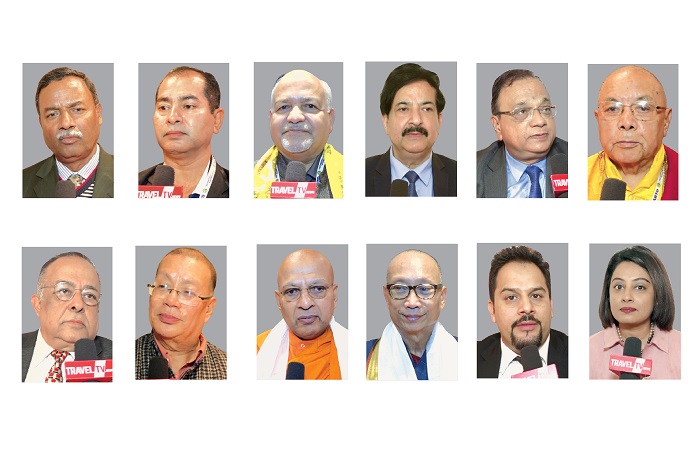Ministry of Tourism is focused on promoting the Buddhist circuit in India, a segment that holds immense potential. The Association of Buddhist Tour Operators (ABTO) and participants at the International Buddhist Travel Mart in Bodh Gaya provide insights on this potential and challenges of Buddhist tourism.
JP Shaw, President, ABTO
“We want sensitisation and awareness created among the people of this destination, and other stakeholders, on the importance of tourism in the Buddhist sector. Participation from numerous countries like Nepal, Vietnam, Thailand, Sri Lanka, Malaysia and Taiwan, among others, will go a long way.”
Kaulesh Kumar, Secretary General (Founder), ABTO
“While there is huge potential in Buddhist tourism, we just need to intensify our efforts to promote it. There is a need to generate new markets to pro- mote Buddhist tourism. We want to share with the world about the Diamond Triangle of Udayagiri, Ratnagiri and Lalitgiri, which can be a lifeline for tourists and Buddhists of different countries.”
Ravindra Panth, Senior Advisor, ABTO
“Only the Mahabodhi Temple in Bodh Gaya is a living heritage site, while others come under the purview of ASI. If the sites are converted into living heritage sites, people will be able to carry on their rituals and meditation without restrictions and tourism will definitely grow.”
Vinod Zutshi, Former Secy, Department of Tourism, GOI
“Buddhist tourism can be promoted under four relevant segments that include pilgrimage; educational tours; heritage tourism for those who’d like to understand Buddhist culture some more; and spiritual tourism for those seeking it within India. These are the four segments that need to be marketed.”
Ravi Bankar, Founder, Genesis Leisure Consulting
“The Buddhist circuit is essentially characterised by ‘package tourism’, where anywhere between 80-90 per cent of the tourists come on group packages. Since itineraries are controlled by tour operators, elements like tour guides, ground handlers or local transporters, and local travel agents do not benefit when they need to.”
Lama Lopzang, Founder, International Buddhist Confederation
“The maximum number of people coming here from all over the world is for pilgrimage, while tourists come to seek and gain knowledge. We want more people to come here to see the heritage site of Buddha and seek blessings. Bodh Gaya, Rajgiri, Varanasi, Kushinagar, and Lumbini are some important places.”
Bikram Pandey Kaaji, Goodwill Ambassador, Nepal
“What I am trying to work for is cross-border tourism, with an innovative package called ‘Great Renunciation’. Gautama Buddha left behind his luxurious life, on a white horse – Kanthaka – in search of truth. We could have a tour where all tourists ride a horse from the palace in Kapilavastu, near Lumbini, and begin the circuit tour.”
Kiran Lama, Secretary, Daijokyo Buddhist (Japanese) Temple
“We have an 80-foot Buddha statue here, adjacent to the temple. Pilgrims from all over Southeast Asia, Europe, America, and Russia also visit in large numbers during the pilgrim season. Tourism also plays an important role and so, interesting pack- ages should be made so that people come to these sacred places through tourism.”
VDK Dhammarantana, Chief High Priest, Ti-Ratana Welfare Society
“For Buddhism and Buddhists alike, four places are extremely important – the birthplace of Lord Buddha, where he attained enlightenment, where he gave his first sermon, and the place he passed away at. Buddhists, at least once in their lifetime, must visit these four places and pay their respects.”
Shih Lien Hai Master, President, Worldwide Buddhist Dev. Association
“Lord Buddha is the main teacher for all the different sects of Buddhism all over the world, and that is why we all come here to Bodh Gaya. In my opinion, the Indian government should play a bigger role in encouraging them and people from all over the world to come here. Infrastructure, connectivity, and other facilities need to be developed.”
Manvir Singh Thakur, General Manager, Oaks Bodh Gaya
“In order to encourage more people to visit Bodh Gaya, we need good connectivity and transport facilities. It’s important to encourage hygiene and cleanliness and develop places. We are a part of the Minor group of hotels, an international chain, and have more than 552 properties around the world. This is our first project in India.”
Menik R Wakkumbura, Lecturer – Faculty of Arts, University of Colombo
“Over a period of time, Sri Lankans have increasingly become keen to visit Bodh Gaya because of its religious significance. The main challenge, however, to get to the destination is lack of good air connectivity. If connectivity is improved and travel is made comfortable, a lot more tourists would want to visit.”
 TravTalk India Online Magazine
TravTalk India Online Magazine





